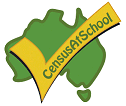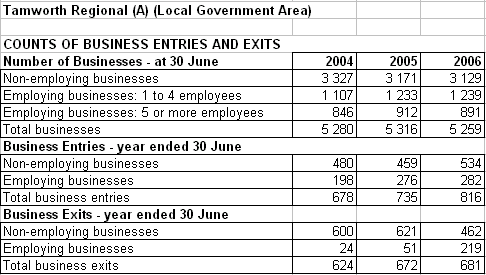Education News - September, 2008
This newsletter highlights the latest curriculum related teaching resources, student activities and statistical tools that have been developed by ABS Education Services as well as other ABS resources that are useful for schools.
Contents
- CensusAtSchool 2008
- An Idea for the Classroom
- New Economic Resources for the Senior Classroom
- Free Teacher Librarian Information Sessions
- National Regional Profiles Updated
- Basic Community Profile Video Tutorial
- Australian Statistics Poster Competition
- Conference Participation
- Recently Released Publications
- Contact details
1. CensusAtSchool 2008 Data Now Available
 CensusAtSchool 2008 data is now available. Already there have been almost 10,000 random samples generated since the data became available in July. Along with Random Sampler release - a range of Information Tables, Prepared Samples, Classroom Activities and Results Tables have also been updated with 2008 data, ready for use in the classroom. These resources are described below:
CensusAtSchool 2008 data is now available. Already there have been almost 10,000 random samples generated since the data became available in July. Along with Random Sampler release - a range of Information Tables, Prepared Samples, Classroom Activities and Results Tables have also been updated with 2008 data, ready for use in the classroom. These resources are described below:
Information tables
If you like the option of a paper version of CensusAtSchool data, browse through the 2008 Information Tables in Word format. A range of tables, some with summary information, have been divided into special categories to help you find what you're looking for, the range of topics for investigation has been expanded since 2006.
Prepared Samples
These prepared data samples are designed for times when internet access is an issue. There are three types of samples available, all in Excel format: simplified samples, unsimplified samples and those extracted from CensusAtSchool classroom activities. Simplified samples have been generated via the Random Sampler and refined for a particular question, making it easier to analyse a specific topic. The samples extracted from activities are also simplified.
CensusAtSchool Classroom Activities
A wide range of CensusAtSchool activities with direct links to state & territory curricula. These have been designed by practising teachers for students in Years 5-10. Activities will soon be updated with 2008 data. A NEW activity has been added investigating how internet access has changed since 2006.
Results tables
Over 44,000 students from 3,500 schools submitted a CensusAtSchool questionnaire in 2008. The results tables present summary statistics of the information collected from students. Choose between 2006 and 2008 results, as well as comparisons between 2006 and 2008 response data. When using these tables, please remember that although the data may be indicative of Australian students' lifestyle, habits, opinions and trends - it cannot be taken as representative.
| How to get involved: Generate a Random Sample from the Student Area of the website. Please contact the CensusAtSchool Team if you have a query or if you would like to provide some feedback. We'd love to hear from you. |
2. An Idea for the Classroom
Do you have a classroom idea that uses ABS data or ABS Education products? Let us know at education@abs.gov.au and we can share it with schools around Australia.
With the current media interest in teenage drinking, the ABS figures on apparent alcohol consumption are a great starting point for discussing this issue. Social Dataset S6 shows the apparent consumption of alcohol per person for 2005, 2006 and 2007. This data is graphed below. Are there any trends in the data? What are they? What other information do you need to address the issue of 'teenage drinking'?

Source Apparent Consumption of Alcohol, Australia, 2006-07 (Reissue) Table 5
As this is a topic that should interest your students, it can be a great vehicle for improving their statistical literacy as is presents an excellent opportunity to ask about the data itself. How is the ABS data collected? What are its limits? (This information can be found on the relevant Explanatory Notes page for ABS publications.) What other data is available? Who collected it? Do they have a vested interest? Who is interpreting the data? What other interpretations may be made? If we encourage our students to question data, we will encourage them to become fully participarting citizens.
3. New Economic Resources for the Senior Classroom
As Australia's national statistical agency, the ABS produces most of the statistics that are at the heart of Economics courses - CPI, GDP, labour force figures, etc. Now you can see exactly how and where ABS publications fit into your Economics course. These handy guides link each section of each State and Territory course to appropriate ABS publications. Don't forget, all ABS publications are FREE to download from the ABS website.
4. Free Teacher Librarian Information Sessions
 Teacher Librarian Information Sessions have begun. It was a full house at Cyberschool at the University of Queensland for the very successful Brisbane session in August. The Canberra and Sydney days will be happening on 23 September. If you haven't already expressed an interest, call or email the contact in your state/territory to ensure that you don't miss out. Teacher Librarian Information Sessions have begun. It was a full house at Cyberschool at the University of Queensland for the very successful Brisbane session in August. The Canberra and Sydney days will be happening on 23 September. If you haven't already expressed an interest, call or email the contact in your state/territory to ensure that you don't miss out.
These free, hands-on internet workshops will show you how to quickly access up-to-date information from the ABS website for many subject areas and year levels. As well, you'll discover the many on-line products and resources developed especially for teachers.
Places are limited
These workshops are free and have limited numbers, so they will fill quickly. To secure your place, RSVP to the relevant contact above, with your name, contact details and school.
If you would like further information contact the relevant person in your state/territory or call Education Services on Freecall 1800 623 273. |
 |
 |
5. National Regional Profiles Updated
The National Regional Profile (NRP) has recently been updated to include the most current data. Regional profiles are available on the whole of Australia and the states and territories, as well as Local Government Areas and Statistical Local Areas. These profiles allow users to compare characteristics of different geographical regions across Australia. Each regional profile contains sections on the economy, population/people, industry and environment/energy.
A comprehensive 'help' section is also provided which includes a series of video demonstrations on how to effectively use the NRP. The video demonstrations will show you how to access areas of interest to you, as well as compare different areas. Regional profiles are an exciting educational resource that can be especially useful in geography studies.
You can get snapshots of your area that include data from 2002 to 2006, on a range of topics covering Economy, People/Population, Industry and Environment/Energy - from registered vehicles per 1,000 persons, to occupation, to crime statistics, and even population density. As an example, the table below shows the number of businesses, business entries and business exits for Tamworth Regional LGA for 2004, 2005 and 2006.

As well, you can compare your area with other areas. Table 2 below shows the estimates of unemployment for eight different Local Government Areas over 5 years. These values come from SuperTable files so you will need to download the free software before you can access these. There is also a video tutorial on using the comparative National Regional Profile data.

This information could be used in a wide range of classrooms - Commerce/Economics, Geography, Social Studies and more.
 |
6. Basic Community Profile Video Tutorial
The Basic Community Profile Video Tutorial is the first in a series of online video tutorials designed to assist users to better navigate and understand Census data and information. It provides step-by-step instructions on how to access the information in the Basic Community Profiles. Basic Community Profiles consist of 45 tables containing key Census characteristics on persons, families and dwellings.
|
7. Australian Statistics Poster Competition- Closing Soon!

Don't forget to submit your students' entries in for the Australian Statistics Poster Competition . This competition is run by the University of Southern Queensland with ABS sponsorship. It fits well into chance and data streams of school mathematics courses and allows the content to be covered using a project based approach. Posters must be submitted by 12 September 2008, so hurry as there are merely days remaining!
There is a fee of $19.80 per team to cover the administrative costs of running the competition and registration is required.
Some useful resources
As well as information about the competition, the web site includes 'Notes on Statistical Analysis' (pdf 148 kB) which includes a very useful summary for data analysis as well as information to help students use the correct graphs, tables and analyses for their investigation. Another paper that discusses the use of statistics in scientific investigations, 'Statistical Literacy and Scientific Investigation' (pdf 112 kB) is available from the ABS website.
8. Conference Participation |
Have you caught up with Education Services at a conference yet? Since the last newsletter staff have presented at a number of conferences around the country.
The Business Educators Australia conference in Melbourne offered the chance to demonstrate to Economics, Business Studies and Legal Studies teachers just how much relevant information there is on the ABS website and to show them how to easily access it. At the International Middle Years conference in Adelaide teachers were enthusiastic that there was a resouce - CensusAtSchool - that linked the theory of middle years education to the practicalities of the classroom. The Geography Teachers Association of Victoria conference saw participants learn how to make the most of the wealth of Census 2006 data and the Canberra Maths Association conference offered the Year Book Australia, 2008 to one lucky participant.
9. Recently Released Publications
The recently released
Crime and Justice News, 2008 (cat. no. 4500.0) is the annual newsletter of the National Centre for Crime and Justice Statistics (NCCJS) at the ABS. It provides snapshot data from NCCJS publications, as well as information about current issues in the crime and justice sector. For more comprehensive information, the
Crime and Justice theme page provides links to relevant ABS publications. The NCCJS produces numerous resources of educational value, particularly for humanities and legal studies courses.
The 2008 edition of
Australian Social Trends (cat. no. 4102.0) presents information on contemporary social issues and areas of public policy concern in nine detailed chapters. The first seven chapters cover core areas of social interest, such as health, education and training and economic resources. Chapter eight provides information on additional areas of social concern, which in this year's edition covers internet usage and public transport.
Want to know how the unemployment rate in China compares to Australia? Chapter nine provides international comparisons on areas of social interest in a series of summary tables. This publication can be useful across all disciplines, but has particular relevance for humanities and social science courses.
For the record, China's unemployment rate is 4.2% for the selected reference year, compared to 5.0% for Australia!
| The Health and Welfare of Australia's Aboriginal and Torres Strait Islander Peoples, 2008 (cat. no. 4704.0) provides a comprehensive statistical overview of Aboriginal and Torres Strait Islander health and welfare. Among the topics included are: demographic and population characteristics, housing circumstances, maternal and child health, health risk factors, health status, disability, mortality and access to, and use of services. This publication is a joint venture between the ABS and Australian Institute of Health and Welfare. |
Remember, all ABS publications are free to download from the ABS website.
10. Contact details
 Print Page
Print Page
 Print All
Print All